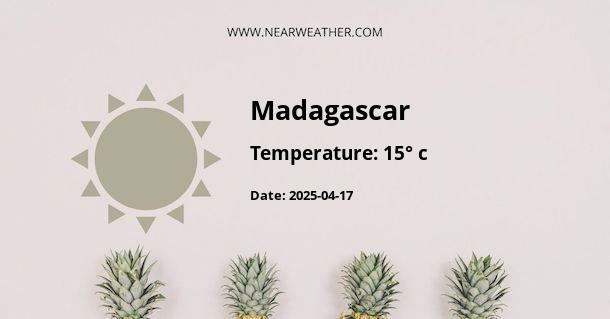Climate and Weather in the Republic of Madagascar, MG
The Republic of Madagascar, located in the Indian Ocean off the southeastern coast of Africa, is known for its rich biodiversity and unique ecosystems. The country's climate and weather vary depending on the region, with diverse landscapes and topography contributing to different climatic patterns. Understanding the climate of Madagascar is crucial for tourists, researchers, and residents alike. In this article, we will explore the climate and weather conditions in the Republic of Madagascar throughout the year.
Geographical Features
Madagascar is the fourth largest island in the world, covering an area of approximately 587,041 square kilometers (226,658 square miles). The island's diverse topography includes mountains, plateaus, rainforests, and coastal plains. These geographical features greatly influence the climate and weather patterns across the country.
Seasonal Climate
Madagascar experiences two main seasons: a hot rainy season and a cooler dry season.
Rainy Season (November to April)
The rainy season in Madagascar occurs from November to April. During this period, the country experiences heavy rainfall and high humidity. The northern and eastern regions receive the most precipitation, with an average of 2,000 to 3,500 millimeters (78 to 138 inches) of rainfall annually. This high amount of rainfall supports the lush rainforests and diverse wildlife in these areas.
During the rainy season, tropical cyclones, known locally as "Cyclones," can affect the coastal regions of Madagascar. These cyclones bring strong winds, heavy rainfall, and the risk of flooding and landslides. It is important to monitor weather forecasts and take necessary precautions during this time.
Dry Season (May to October)
The dry season in Madagascar occurs from May to October. This period is characterized by cooler temperatures, lower humidity, and minimal rainfall. The western and southern regions of the country are significantly drier compared to the rest of Madagascar, with some areas experiencing arid conditions.
During the dry season, temperatures can vary depending on the region, with coastal areas experiencing milder temperatures compared to the inland areas. The average temperature in Madagascar ranges from 20°C to 27°C (68°F to 81°F) during this season, making it a popular time for tourists to visit the country.
Regional Variations
Madagascar's diverse topography and geographical location contribute to regional variations in climate and weather conditions.
Highland Climate
The central highlands of Madagascar, which include Antananarivo, have a unique climate characterized by cooler temperatures compared to the rest of the country. The average temperature in the highlands ranges from 16°C to 22°C (61°F to 72°F) throughout the year. The highlands also experience distinct wet and dry seasons, with most of the rainfall occurring from November to April.
Coastal Climate
The coastal regions of Madagascar, including popular tourist destinations such as Nosy Be and Toliara, have a tropical climate. The temperatures along the coast range from 25°C to 32°C (77°F to 90°F) throughout the year. These areas experience high humidity and receive significant rainfall, especially during the rainy season.
Eastern Climate
The eastern region of Madagascar, including the Masoala Peninsula and the rainforests of Ranomafana National Park, is known for its high rainfall and humid climate. This area receives the most precipitation in the country and is characterized by dense rainforests and diverse wildlife.
Western Climate
The western region of Madagascar, including the spiny forests of Ifaty and the Baobab Alley, has a drier climate compared to other parts of the country. This area experiences arid conditions, especially during the dry season, with average annual rainfall ranging from 300 to 800 millimeters (12 to 31 inches).
Climate Change
Like many other regions around the world, Madagascar is also experiencing the impacts of climate change. Rising temperatures, changing rainfall patterns, and increased frequency of extreme weather events pose significant challenges to the country's ecosystems and communities.
It is important for Madagascar to prioritize sustainable practices, conservation efforts, and adaptation strategies to mitigate the effects of climate change and protect its unique biodiversity.
Conclusion
The Republic of Madagascar experiences a diverse range of climates and weather patterns throughout the year. From the rainy season with heavy rainfall and tropical cyclones to the cooler and drier dry season, the country offers a variety of climatic conditions. The regional variations in climate, such as the highland, coastal, eastern, and western climates, add to the uniqueness of the country's weather. However, it is crucial to consider the impacts of climate change and take necessary measures to protect Madagascar's ecosystems and communities for future generations.
A - Madagascar's Latitude is -20.000000 & Longitude is 47.000000.
A - Weather in Madagascar is 17° today.
A - Climate Conditions in Madagascar shows light rain today.
A - Humidity in Madagascar is 85% today.
A - Wind speed in Madagascar is 6.48 km/h, flowing at 61° wind direction. today.
